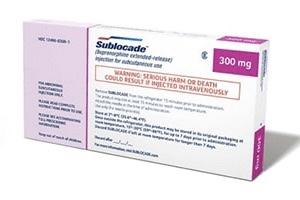Sublocade and Alcohol/Food Interactions
There is 1 alcohol/food/lifestyle interaction with Sublocade (buprenorphine).
Buprenorphine Food/Lifestyle
Major Food Interaction
GENERALLY AVOID: Alcohol may potentiate the central nervous system (CNS) depressant effects of opioid analgesics including buprenorphine. Concomitant use may result in additive CNS depression and impairment of judgment, thinking, and psychomotor skills. In more severe cases, hypotension, respiratory depression, profound sedation, coma, or even death may occur.
MANAGEMENT: Patients taking buprenorphine should not consume alcohol or use medications that contain alcohol on days of buprenorphine dosing. In general, potent narcotics such as buprenorphine should not be combined with alcohol.
References (4)
- (2023) "Product Information. Sublocade (buprenorphine)." Indivior Inc., SUPPL-28
- (2023) "Product Information. Probuphine (buprenorphine)." Titan Pharmaceuticals Inc, SUPPL-14
- (2023) "Product Information. Buprenorphine (buprenorphine)." G.L. Pharma UK Ltd
- (2023) "Product Information. Temgesic (buprenorphine)." Reckitt Benckiser Pty Ltd
Switch to consumer interaction data
Sublocade drug interactions
There are 728 drug interactions with Sublocade (buprenorphine).
Sublocade disease interactions
There are 12 disease interactions with Sublocade (buprenorphine) which include:
- drug dependence
- respiratory depression
- gastrointestinal obstruction
- intracranial pressure
- adrenal insufficiency
- hypotension
- liver disease
- QT prolongation
- renal dysfunction
- urinary retention
- seizure disorders
- biliary tract disease
More about Sublocade (buprenorphine)
- Sublocade consumer information
- Check interactions
- Compare alternatives
- Reviews (307)
- Drug images
- Latest FDA alerts (5)
- Side effects
- Dosage information
- Patient tips
- During pregnancy
- Support group
- FDA approval history
- Breastfeeding
- En español
Related treatment guides
Drug Interaction Classification
| Highly clinically significant. Avoid combinations; the risk of the interaction outweighs the benefit. | |
| Moderately clinically significant. Usually avoid combinations; use it only under special circumstances. | |
| Minimally clinically significant. Minimize risk; assess risk and consider an alternative drug, take steps to circumvent the interaction risk and/or institute a monitoring plan. | |
| No interaction information available. |
See also:
Further information
Always consult your healthcare provider to ensure the information displayed on this page applies to your personal circumstances.


